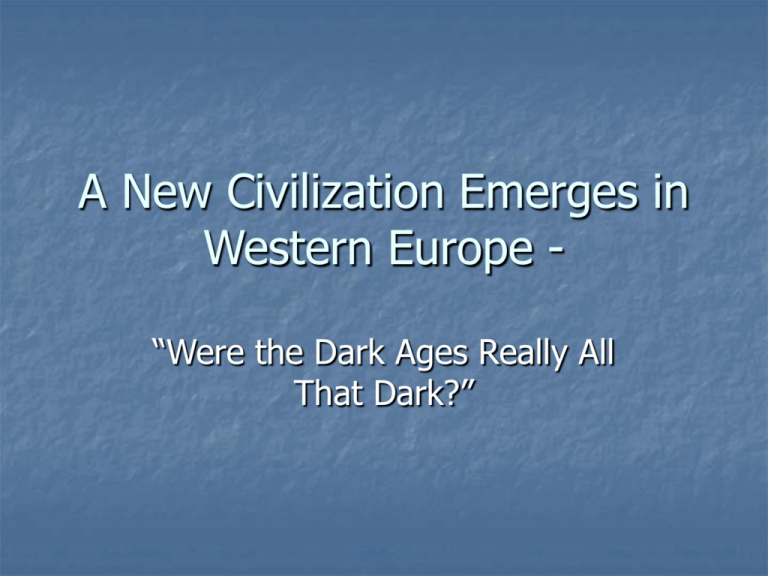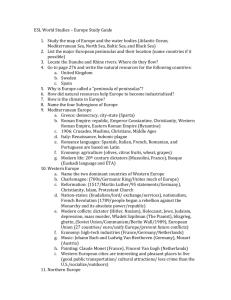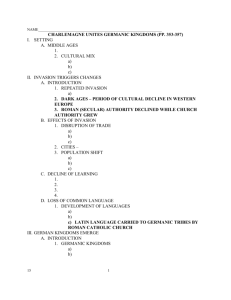apworldchapter10middleages1
advertisement

A New Civilization Emerges in Western Europe “Were the Dark Ages Really All That Dark?” The Germanic Peoples The Western Roman Empire fell to Germanic invaders in 476 C.E. – historians mark this as the start of the Middles Ages/Dark Ages – the time between the Roman Empire and the Renaissance in Europe. The early Middle Ages may be called “Dark” in the sense that the unity the Roman Empire brought to Europe was destroyed. Theodoric the Great – the Ostrogoth king tried to rule Roman by maintaining the Senate, etc. – but continued invasions destroyed the political unity that Rome provided. The Germanic peoples were people from Eastern Europe and Eurasia. They had similar languages and cultural backgrounds. The largest of the invading groups were: Franks Ostrogoths Lombards Visigoth Saxons Angles Alemanii Thuringians Vandals The Germanic peoples invaded and conquered most of Europe by the 600s. They mixed with the local populations over time. With the removal of Roman political power and unity – local chieftains assumed power and began to divide Europe into many smaller realms – eventually kingdoms. The Roman Catholic Church When the political entity that was Rome was destroyed – the Christian Church in Rome became the only force that provided any sense of unity in Europe. As the Germanic invaders became Christian – the Church gained influence and the new converts gained legitimacy. The Church became the center of daily life in most areas – as the Church was the source of most education, health care – really all aspects of life. Many men and women entered religious life as priests, monks, and nuns. In many ways, a life in the Church provided people with more education and stability than as lay people. Monasteries, abbeys and nunneries grew throughout Europe. Gregory the Great Pope Gregory the Great Supported the monastic movement and the Christianization of the Germans. This broadened and strengthened the Church. Monks and nuns maintained knowledge of medicines, botany and other sciences. Monks copied the Bible as well as important books. Many thank the Irish monks for maintaining the knowledge of the West – as they copied books and protected them from the Vikings and other invaders. St. Benedict St. Benedict of Nursia was born to a wealthy Roman family ca. 480 C.E. As a priest he established religious communities for monks. The early days of Christianity saw myriad communities of monks, nuns, hermits, etc. with various rules and systems of organizations. Benedict established “The Rule of St. Benedict” which gave structure and guidelines to early Christina religious orders. He is viewed as the father of monasticism. As medieval society developed, the Catholic Church expanded its bureaucracy – in religious and secular areas. New religious orders such as the Franciscans and the Order of St. Clare dramatically changed the relationship of the Church with the people of Europe. Theology and Reason The philosophy of the Hellenistic world did not disappear after the fall of the western Roman Empire – but the study and application of those philosophies was centered in the Byzantine and Islamic worlds. The Crusades, trade, and other points of contact led the philosophies of the Hellenistic and Roman worlds to return to western Europe through cultural diffusion. BUT…how would these pre-Christian ideas fit in a world centered about the Catholic Church? Aristotle was praised by medieval scholars for his sense of logic. French writer PETER ABELARD 1079-1142 C.E. in his work Yes and No used the new examination of logic to question commonly held beliefs in all aspects of life – including religion. What happens if people begin to question??? Ask me about Heloise…. Is Reason Dangerous? Many in the Church believed that reason would cause people to question faith and doctrine. BERNARD OF CLAIRVAUX – monk – believed that Abelard was wrong and that one should use only faith and not reason in matters of religion. St. Thomas Aquinas ca. 1225-1274 Scholar and monk Thomas Aquinas calmed the debate between faith and reason with his work Summa Theologica St. Thomas Aquinas stated that faith is above all, but that God had organized the world coherently and that reason and logic were tools to understand the natural order. The Book of Kells Churches and Architecture The Church provided people with refuge in a time of chaos and confusion Perhaps more than at any other time – people were concerned with religion – their church and their own salvation. Life was short and brutal for most people – the hope of an afterlife influenced many of their actions. People sought to praise God through building beautiful churches. Thousands and thousands of churches and cathedrals were built throughout Europe. Each church tried to outdo the others – with architecture, riches and relics. The early churches of the Middle Ages were built in a style called ROMANESQUE – based on the architecture of the Roman Empire. Walls were thick in order to support high ceilings. Gothic As the Middle Ages went on – architects developed a keener sense of physics and began to build churches in the GOTHIC STYLE. High vaulted ceilings Large stained glass windows Thinner yet higher walls – flying buttresses Very ornate exteriors Chartres Westminster Abbey Flying Buttress Feudalism With the fall of the Roman Empire – Europeans developed a system of political/social connection known as FEUDALISM. Feudalism was a system of responsibility At the top of the feudal system was the LORD of the land. People below him were his VASSALS. The land the lord gave out was called a FIEF. This was a bureaucratic way to control a kingdom. The lord usually lived in the manor house or castle. Early castles were often built of wood in the moat and bailey format. At the bottom of the feudal system were the peasants – most of whom were SERFS. They were not slaves in the normal sense – no one owned them. Instead, they were bound to the land – the MANOR. They could not leave the place where they lived. They had to grow food or produce products for the lord. In return, the lord promised military protection. Knights Wealthy young men often became knights – professional soldiers for their lord. The costly armor and horses meant that a knight was something a peasant almost never became. The knights – in theory – organized their lives around codes of knightly behavior called the CODE OF CHIVALRY. In theory – knights protected the weak and defenseless. Most soldiers were NOT KNIGHTS. The knights were fighters but also well educated members of high society. Most soldiers were from the peasantry and had joined the lord’s army – often to escape the toil of farming. Long Bow Medieval Economics in Europe While agriculture would be the base of European economics for hundreds of years, the medieval period saw the development of trade and banking – that would lead to the development of capitalism. The Crusades demanded huge amounts of money – most of which came from banking families. Contact with the Byzantine and Islamic worlds led to a demand for foreign luxury goods – which required shipping – which required money to establish businesses – banks. Inter-continental trade flourished – ex. English wool was traded in the markets of the Low Lands and sold throughout the continent. Manufacturers organized into GUILDS – with guilds and guild masters controlling manufacturing and pricing – journeymen Cities in the Baltic organized into the HANSEATIC LEAGUE – combining trading forces in order to achieve a greater combined profit. The German Peoples in Middle Ages Europe Germanic peoples moved into present day Scandinavia and northern Germany about 750 B.C.E. They were generally migratory people. Not nomads, but people who often moved every few generations in search of better lands Some of the Germanic tribes were: Ostrogoths Visigoths Saxons Angles Franks Vandals Alemanii The Germanic peoples met a powerful force in the Roman Empire. Despite their desire to move into Roman lands – the Germanic peoples were pushed back by the Roman legions. As the Roman Empire weakened, the Germanic peoples pushed more and more into Roman lands. While the Romans usually brought new peoples into the Roman Empire, they usually kept the Germanic peoples outside – sometimes taking them as slaves. By the 400s, the Germanic invaders were taking advantage of Roman weakness in order to destroy the Roman Empire in the West. After taking control over most of Western Europe – the Germanic peoples began to convert to Christianity. The Franks The Germanic peoples who lived in what the Romans called Gaul were the Franks. The Franks were ruled in the 400s by the MERGOVIAN DYNASTY – the best known Mergovian Frank king was Clovis who built the great Frank Empire. By the early 700s, the Mergovian kings had a title – but the real power lay with their chief advisor the “mayor of the palace” The Carolingians In 732, Charles Martel defeated the Muslims at the French town of Tours. This stopped the Muslim invasion of Europe. The popes of this time looked to Charles Martel and his family to save Christendom. In the 750s, Charles Martel’s son, Pepin, defeated the Lombards – who were controlling central Italy. Pepin gave the Lombard kingdom that he conquered to the pope. This was known as the DONATION OF PEPIN. It strengthened the link between the Carolingian Franks and the papacy. The successes of Charles Martel and his son Pepin led them to assume control over the Franks – taking it away from the Mergovians kings. This received the approval of the pope because of the battles Charles Martel and Pepin fought in order to help the papacy. Charlemagne Pepin was succeeded by his son Carl (Charles in English) (Carolus in Latin). He was soon known as Charles the Great or CHARLEMAGNE. Charlemagne wanted to build a kingdom larger and stronger than the kingdom of his father’s. Charlemagne’s motto was Renovatio imperii romani – Renewal of the Roman Empire Creation of the Holy Roman Empire Charlemagne established a system of bureaucracy and hierarchy within his lands. This allowed the kingdom to run efficiently and it strengthened his control over the land and the nobles. In 800, Pope Leo III crowned Charlemagne as “Emperor of the Romans” and established the Holy Roman Empire. This was an attempt to bring stability to Europe in the days after the fall of the Roman Empire. The term “Holy” in the H.R.E. comes from the fact that it was the pope and Christianity creating the empire – not merely military force.








